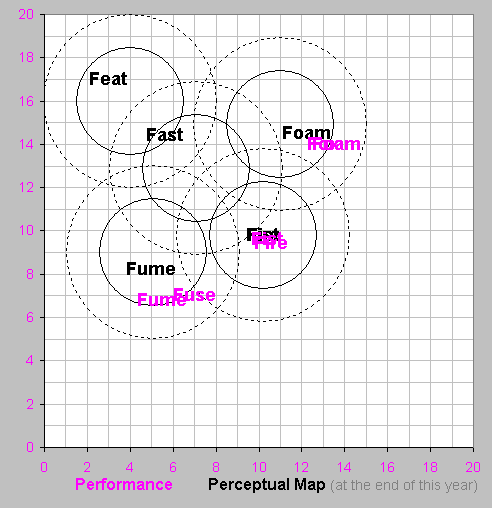12.6 Niche Differentiation - Practice Round 3
Practice Round 3
R & D Round 3
Fast - No change required. Fast is entering the Low End segment. Next round, reduce reliability (MTBF) to 12000 hours.
Feat - No change required.
Fist - Improve positioning and reduce age. Hold reliability (MTBF) steady. Example: Increase Fist's performance by 0.2 and decrease size by 0.2.
Foam - Improve positioning and reduce age. Hold reliability (MTBF) steady. Example: Increase Foam's performance by 1.4, decrease size by 0.5.
Fume - Improve positioning and reduce age. Hold reliability (MTBF) steady. Example: Increase Fume's performance by 0.5 and decrease size by 1.4.
New High End Product - Tweak positioning and reduce age. Hold reliability (MTBF) steady. Example: Increase Performance by 0.4 and decrease size by 0.4.
New Performance Product - No change required. The product will emerge later this year.
New Size Product - Launch a new Size product, with a project length of 20 to 24 months (no later than December of next year.) Example: Name: Fuse (replace the first NA in the list), positioned at leading edge of the Size segment, say Performance 7.0, Size 7.0. Set MTBF near the middle of the Size reliability (MTBF) range: MTBF 19000.

Marketing Round 3
Fast - Reduce price, maintain promotion and sales budgets. Fast is now a Low End product, but since Fast is not a "good" Low End product, plan for poor sales. Example: Price $23.00, promotion budget $600, sales budget $600, and sales forecast 800.
Feat - Reduce price, maintain promotion and sales budgets. Forecast unit sales near last year's level. Example: Price $20.00, promotion budget $600, sales budget $600, and sales forecast 1150.
Fist - Hold price high, maintain promotion and sales budgets. Forecast improved unit sales. Example: Price $38.00, promotion budget $2000, sales budget $2000, sales forecast 900.
Foam - Hold price high, maintain promotion and sales budgets. Forecast improved unit sales. Example: Price $33.00, promotion budget $2000, sales budget $2000, sales forecast 950.
Fume - Hold price high, maintain promotion and sales budgets. Forecast improved unit sales. Example: Price $33.00, promotion budget $2000, sales budget $2000, sales forecast 950.
New High End product - Price high, mirror promotion and sales budgets of other high technology products. Forecast good unit sales. Example: Price $38.00, promotion budget $2000, sales budget $2000, sales forecast 800.
Production Round 3
For each product, schedule production using the formula:
(Unit Sales Forecast X 1.15) - Inventory On Hand
Important: As your new product is coming out sometime during the year, you might not be able to use the above formula - new products cannot begin production prior to their revision (release) date. Should the number you enter into the production schedule turn red, reduce the schedule until the red number turns black.
Fast - Sell 1,000,000 units of capacity by entering -1000 in the Buy Sell Capacity cell.
Feat - Sell 700,000 units of capacity by entering -700 in the Buy Sell Capacity cell.
Fist - Increase automation by 1.0 or 2.0 points.
Foam - Increase automation by 1.0 or 2.0 points.
Fume - No change required.
New High End Product- No change required.
New Performance Product - Buy 600,000 units of capacity by entering 600 in the Buy Sell Capacity cell. Set an automation level of 5.0.
New Size Product- No change required. The product will emerge later this year.
Important: There is a one year lag between purchase and use of new capacity and automation for both new and existing products.
Finance Round 3
You may have cash on hand to cover your plant and equipment investment. If not, issue stock to cover the shortfall.
Look at the proforma balance sheet, and add together your cash and inventory accounts. Apply the following rule of thumb. Keep between 15% and 20% of your balance sheet assets in cash plus Inventory. You do not care about the mix, but you do want to have adequate reserves to cover unexpected swings in inventory.
Adjust your cash position to meet the guideline from Round 1. If you are cash poor, issue stock. If you are cash rich, pay dividends and buy back stock.
Do not issue current debt.
Save decisions (select "directly to the website").
